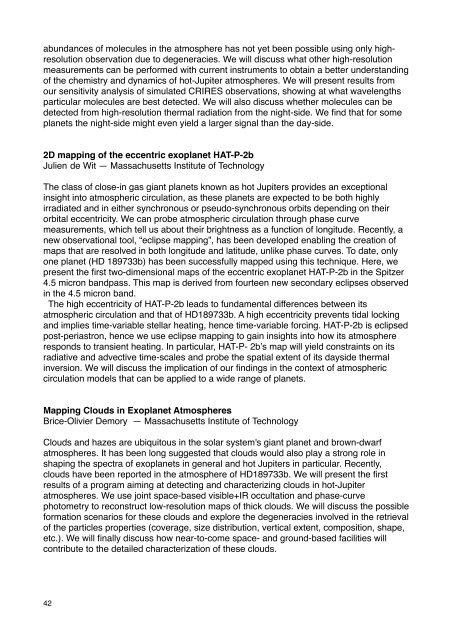Exoclimes_Conference_booklet1
Exoclimes_Conference_booklet1
Exoclimes_Conference_booklet1
You also want an ePaper? Increase the reach of your titles
YUMPU automatically turns print PDFs into web optimized ePapers that Google loves.
abundances of molecules in the atmosphere has not yet been possible using only highresolution<br />
observation due to degeneracies. We will discuss what other high-resolution<br />
measurements can be performed with current instruments to obtain a better understanding<br />
of the chemistry and dynamics of hot-Jupiter atmospheres. We will present results from<br />
our sensitivity analysis of simulated CRIRES observations, showing at what wavelengths<br />
particular molecules are best detected. We will also discuss whether molecules can be<br />
detected from high-resolution thermal radiation from the night-side. We find that for some<br />
planets the night-side might even yield a larger signal than the day-side.<br />
2D mapping of the eccentric exoplanet HAT-P-2b!<br />
Julien!de Wit — Massachusetts Institute of Technology<br />
The class of close-in gas giant planets known as hot Jupiters provides an exceptional<br />
insight into atmospheric circulation, as these planets are expected to be both highly<br />
irradiated and in either synchronous or pseudo-synchronous orbits depending on their<br />
orbital eccentricity. We can probe atmospheric circulation through phase curve<br />
measurements, which tell us about their brightness as a function of longitude. Recently, a<br />
new observational tool, “eclipse mapping”, has been developed enabling the creation of<br />
maps that are resolved in both longitude and latitude, unlike phase curves. To date, only<br />
one planet (HD 189733b) has been successfully mapped using this technique. Here, we<br />
present the first two-dimensional maps of the eccentric exoplanet HAT-P-2b in the Spitzer<br />
4.5 micron bandpass. This map is derived from fourteen new secondary eclipses observed<br />
in the 4.5 micron band.<br />
The high eccentricity of HAT-P-2b leads to fundamental differences between its<br />
atmospheric circulation and that of HD189733b. A high eccentricity prevents tidal locking<br />
and implies time-variable stellar heating, hence time-variable forcing. HAT-P-2b is eclipsed<br />
post-periastron, hence we use eclipse mapping to gain insights into how its atmosphere<br />
responds to transient heating. In particular, HAT-P- 2b’s map will yield constraints on its<br />
radiative and advective time-scales and probe the spatial extent of its dayside thermal<br />
inversion. We will discuss the implication of our findings in the context of atmospheric<br />
circulation models that can be applied to a wide range of planets.<br />
Mapping Clouds in Exoplanet Atmospheres<br />
Brice-Olivier Demory — Massachusetts Institute of Technology<br />
Clouds and hazes are ubiquitous in the solar system's giant planet and brown-dwarf<br />
atmospheres. It has been long suggested that clouds would also play a strong role in<br />
shaping the spectra of exoplanets in general and hot Jupiters in particular. Recently,<br />
clouds have been reported in the atmosphere of HD189733b. We will present the first<br />
results of a program aiming at detecting and characterizing clouds in hot-Jupiter<br />
atmospheres. We use joint space-based visible+IR occultation and phase-curve<br />
photometry to reconstruct low-resolution maps of thick clouds. We will discuss the possible<br />
formation scenarios for these clouds and explore the degeneracies involved in the retrieval<br />
of the particles properties (coverage, size distribution, vertical extent, composition, shape,<br />
etc.). We will finally discuss how near-to-come space- and ground-based facilities will<br />
contribute to the detailed characterization of these clouds.<br />
42


